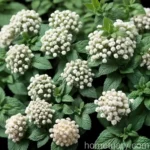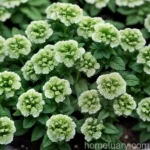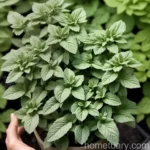Plant Name: Apple Mint (Mentha suaveolens)
Plants have long been an integral part of human life, with various species providing food, medicine, fragrance, and aesthetic beauty. Among the diverse range of plants, the apple mint (Mentha suaveolens) stands out for its aromatic leaves and versatility in both culinary and medicinal applications. In this comprehensive guide, we will delve into the world of apple mint, exploring its cultural preferences, uses, maintenance, and interesting facts. Whether you are an enthusiastic gardener, a culinary aficionado, or a lover of natural remedies, apple mint has something unique to offer.
What is Apple Mint (Mentha suaveolens)?
Apple mint, scientifically known as Mentha suaveolens, is a perennial herbaceous plant belonging to the Lamiaceae family. This delightful herb is renowned for its distinct apple-like scent and flavor, which sets it apart from other mint varieties. While it shares some similarities with spearmint and peppermint, apple mint is characterized by its soft, fuzzy leaves and a pleasant fruity aroma.
Key Takeaways – Apple Mint (Mentha suaveolens)
Before diving deep into the world of apple mint, let’s take a quick look at the key takeaways for this versatile herb.
1. Apple mint, or Mentha suaveolens, is a perennial herb with a delightful apple-like fragrance and taste, making it a popular choice for culinary and medicinal purposes.
2. This herb thrives in moist, well-drained soil and prefers partial shade, making it an excellent addition to home gardens and containers.
3. Culturally, apple mint has been valued for its culinary uses, such as flavoring salads, desserts, beverages, and even being infused in teas.
4. It also possesses medicinal properties, with applications in traditional medicine for respiratory health, digestive support, stress relief, and skincare.
5. Apple mint is relatively easy to grow and maintain, making it suitable for both experienced and novice gardeners.
Now, let’s embark on a detailed exploration of apple mint, covering its culture, uses, care requirements, propagation methods, common diseases and pests, and fascinating fun facts.
Culture: Growing Conditions for Apple Mint
When it comes to cultivating apple mint, understanding its cultural preferences is essential for ensuring its healthy growth and vigor. Let’s delve into the specific conditions that apple mint thrives in.
Water
Apple mint thrives in consistently moist soil, but it’s crucial to avoid waterlogging. This herb benefits from regular watering, especially during dry periods, to maintain adequate soil moisture. However, it’s important to strike a balance and avoid overly saturated soil, which can lead to root rot and other issues.
Sunlight
In terms of sunlight, apple mint prefers partial shade to full sun. Providing dappled sunlight or a few hours of direct morning sun, coupled with afternoon shade, creates an ideal environment for apple mint to flourish. In hotter climates, providing some protection from intense midday sun can prevent the plant from wilting or becoming stressed.
Soil
Apple mint thrives in well-drained, fertile soil with a slightly acidic to neutral pH. A loamy soil type with good moisture retention is well-suited for apple mint cultivation. Incorporating organic matter such as compost into the soil can further enhance its texture and fertility, providing an optimal foundation for the herb’s growth.
Fertilizer
While apple mint is relatively low-maintenance, providing a balanced, organic fertilizer during the growing season can promote healthy foliage and robust growth. Opt for a fertilizer with a balanced N-P-K ratio to support overall plant health without encouraging excessive vegetative growth.
Pruning
Regular pruning is beneficial for apple mint, helping to maintain its bushy growth habit, prevent legginess, and encourage the production of fresh, aromatic leaves. When pruning apple mint, it’s advisable to remove any yellowing or damaged leaves, as well as to periodically trim back the stems to promote new growth. This can be especially important if the plant exhibits signs of overgrowth or has become untidy.
Uses of Apple Mint (Mentha suaveolens)
Apple mint is a versatile herb that offers a wide array of culinary, medicinal, and aromatic applications. From flavoring dishes and beverages to providing natural remedies for various ailments, apple mint is cherished for its multi-faceted utility.
Culinary Uses
One of the primary attractions of apple mint lies in its culinary applications. The aromatic, fruity flavor of apple mint makes it a delightful addition to a variety of dishes, beverages, and garnishes. Some popular culinary uses of apple mint include:
– Flavoring fruit salads, green salads, and grain salads with freshly chopped apple mint leaves.
– Enhancing the taste of summer beverages such as lemonade, iced tea, and fruit-infused water with a sprig of apple mint.
– Incorporating minced apple mint leaves into dressings, marinades, and sauces to infuse a refreshing twist into savory recipes.
– Using apple mint as a garnish for desserts like cakes, sorbets, and fruit-based confections to add a touch of elegance and aroma.
Medicinal Properties
From a medicinal standpoint, apple mint contains essential oils and phytochemicals that contribute to its therapeutic properties. Some of the potential medicinal uses of apple mint include:
– Digestive Health: Apple mint is believed to offer digestive support, with its aromatic compounds potentially aiding in soothing indigestion and bloating.
– Respiratory Health: The menthol content in apple mint lends it potential benefits for respiratory health, with inhalation of its aroma offering relief from congestion and discomfort.
– Stress Relief: The relaxing aroma of apple mint can contribute to stress reduction and relaxation, making it a valuable herb for promoting emotional wellbeing.
– Skincare: The natural astringent properties of apple mint may contribute to its use in skincare, with potential applications in toners, facial mists, and natural skincare formulations.
Aromatic Uses
Beyond its culinary and medicinal properties, apple mint serves as an aromatic delight, infusing the surroundings with its pleasant scent. The leaves of apple mint can be crushed and used as a natural air freshener, enhancing indoor spaces with their refreshing fragrance. Additionally, the aromatic presence of apple mint can be harnessed in crafts, DIY projects, and homemade potpourri blends, adding a touch of natural elegance to the home.
Apple Mint (Mentha suaveolens) Propagation
Propagating apple mint is relatively straightforward and can be achieved through several methods, including division, stem cuttings, and seed sowing.
Division
Dividing the root clumps of established apple mint plants is a simple and effective way to propagate this herb. This method is best carried out in early spring or fall when the plant is not actively stressed by extreme temperatures. By carefully separating the root clumps and replanting them in suitable locations, gardeners can propagate apple mint while also rejuvenating the parent plant.
Stem Cuttings
Taking stem cuttings from healthy, non-flowering apple mint plants offers another successful propagation method. Selecting a 4-6 inch section of a healthy stem and removing the lower leaves before placing the cutting in a pot of moist growing medium can encourage the development of new roots. With adequate moisture and warmth, the cuttings will typically root and establish themselves, leading to new apple mint plants.
Seed Sowing
While apple mint can be propagated from seeds, it’s important to note that this method may produce variations in the resulting plants. To sow apple mint seeds, begin by preparing a seed starting mix and lightly pressing the seeds into the surface. By providing consistent moisture, warmth, and indirect light, the seeds will gradually germinate, leading to the emergence of new apple mint seedlings.
Apple Mint in Containers
The adaptability of apple mint further extends to container gardening, making it an ideal choice for individuals with limited garden space or those looking to harness its charm on patios, balconies, or windowsills.
Container Selection
When choosing a container for apple mint, opt for a spacious pot with ample drainage holes to ensure proper water flow and prevent waterlogging. Selecting a material such as terracotta or plastic can help retain moisture without leading to excessive soil saturation, promoting healthy growth for the herb.
Soil and Growing Medium
Utilize a well-draining, nutrient-rich potting mix when cultivating apple mint in containers. Incorporating organic matter such as compost or peat moss can enhance the texture and fertility of the growing medium, providing an optimal environment for the herb’s roots to thrive.
Watering and Maintenance
In container gardens, apple mint may require more frequent watering compared to plants grown directly in the ground, as the soil in containers tends to dry out more quickly. Monitoring the moisture levels and providing consistent, even watering can support the health and vigor of apple mint in container settings.
Sunlight and Placement
Place the container-grown apple mint in a location that receives partial shade to dappled sunlight, ensuring that it is shielded from intense midday sun, especially in hotter climates. By providing a suitable balance of light and shade, container-grown apple mint can thrive and contribute to the beauty of small-scale garden spaces.
Popularity of Apple Mint
Apple mint has garnered widespread popularity among gardeners, herbal enthusiasts, and culinary aficionados worldwide, becoming a beloved addition to home gardens, community green spaces, and culinary establishments. The herb’s appeal can be attributed to its engaging fragrance, refreshing taste, and versatile applications in cooking, natural remedies, and sensory experiences.
Culinary Appeal
In the culinary realm, apple mint has earned acclaim for infusing dishes and beverages with its delightful flavor and aroma. From enhancing summer salads to lending a refreshing twist to beverages, apple mint has become a sought-after herb for its unique culinary contributions.
Landscape and Garden Charm
Beyond its practical uses, apple mint also adds an aesthetic allure to landscapes, home gardens, and outdoor settings. Its attractive, serrated leaves and appealing growth habit make it an excellent choice for ornamental herb gardens, container displays, and floral arrangements, showcasing its versatility and visual appeal.
Medicinal Value
The medicinal and aromatic properties of apple mint have also contributed to its enduring popularity. With its potential benefits for digestive health, respiratory wellness, stress relief, and skincare, apple mint holds a valued place in natural health and wellness practices, aligning with the growing interest in herbal remedies and holistic approaches to wellbeing.
Common Diseases and Pests of Apple Mint
As with many plants, apple mint is susceptible to certain diseases and pests that can potentially impact its health and vitality. Understanding these common issues and implementing proactive measures can help safeguard apple mint from potential threats.
Disease Diagnosis
Apple mint may be susceptible to certain fungal diseases such as powdery mildew and rust, which can manifest as powdery white spots on the leaves or rusty-colored lesions, respectively. Additionally, issues such as root rot and leaf spot diseases may arise, particularly in conditions of excessive moisture or poor air circulation.
Common Pests
Pests such as aphids, spider mites, and whiteflies can occasionally affect apple mint, feeding on the plant’s sap and potentially causing damage. Regularly inspecting the foliage for signs of pest activity and promptly addressing any infestations can help protect the plant from pest-related stress and damage.
Botanist’s Tips for Cultivating Apple Mint
To maximize the growth and overall health of apple mint, consider the following tips from experienced botanists and herbalists:
- Optimal Moisture: Maintain consistently moist, but not waterlogged, soil to support the herb’s growth and reduce the risk of stress-related issues.
- Partial Shade: Provide partial shade or dappled sunlight to prevent excessive wilting and discoloration, especially in regions with intense sun exposure.
- Pruning and Maintenance: Regularly prune the plant to remove spent or damaged foliage, encourage new growth, and maintain an attractive appearance.
- Healthy Soil: Ensure that the soil is well-draining and enriched with organic matter to provide a nourishing environment for apple mint’s roots.
- Vigilant Care: Keep an eye out for signs of disease and pest activity, addressing any issues promptly to prevent them from escalating.
Fun Facts About Apple Mint
Discover some intriguing and fun facts about apple mint that showcase its unique appeal and diverse uses:
- Apple mint is a natural insect repellent, emitting a scent that deters pests such as mosquitoes and ants, making it a valuable addition to outdoor environments.
- In home gardens, apple mint can serve as a companion plant, offering natural pest control and contributing to the overall biodiversity and health of the garden ecosystem.
- The essential oil derived from apple mint possesses a refreshing, fruity aroma, making it a prized ingredient in aromatherapy and fragrance formulations.
- Apple mint leaves can be utilized in homemade beauty products, enriching skincare formulations with their natural astringent and aromatic properties.
Through these fascinating facts, apple mint’s versatility and charm are illuminated, offering insights into its potential roles in enhancing daily life and natural environments.
Links to External Resources
Explore further information and resources related to apple mint, which can deepen your understanding and appreciation of this captivating herb:
- Growing and Using Mint (Mentha spp.) – North Carolina State University Cooperative Extension
- Growing Herbs Indoors – University of Minnesota Extension
- Mint: A Versatile Herb in the Garden – North Dakota State University Extension
- Herbal Medicine: Biomolecular and Clinical Aspects – National Center for Biotechnology Information
- Aromatherapy: Science Based Evidence? – National Center for Biotechnology Information
- Herbal Cosmetics for Skin and Hair Care – ResearchGate
By delving into these resources, you can access valuable insights, research findings, and practical guidance related to the cultivation, uses, and potential benefits of apple mint in various contexts.
In conclusion, apple mint (Mentha suaveolens) emerges as a captivating herb with a wealth of aromatic, culinary, and medicinal attributes, elevating it to a cherished status in gardens, kitchens, and holistic wellness practices. Whether you are drawn to its culinary nuances, aromatic charm, or wellness potential, apple mint offers a delightful journey of discovery and exploration, enriching lives and environments with its captivating presence. Embrace the art of cultivating, utilizing, and savoring apple mint, as it invites you into a world of sensory delight and natural wonders.
References
- Growing and Using Mint (Mentha spp.) – North Carolina State University Cooperative Extension
- Growing Herbs Indoors – University of Minnesota Extension
- Mint: A Versatile Herb in the Garden – North Dakota State University Extension
- Herbal Medicine: Biomolecular and Clinical Aspects – National Center for Biotechnology Information
- Aromatherapy: Science Based Evidence? – National Center for Biotechnology Information
- Herbal Cosmetics for Skin and Hair Care – ResearchGate















